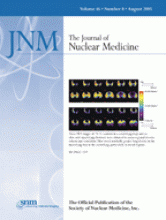Because of the short path length in tissues (<100 μm) and the high linear energy transfer (∼100 keV/μm), α-particle therapy offers the potential for specific tumor cell killing with a low level of damage to surrounding tissues (1). Clinical applications for which this approach is favorable include minimum residual tumor tissue (2,3) and local–regional administration settings (4) as well as targeting of tumor vasculature. Because of the geometry of tumor cell populations, radiation with short ranges in tissue should be desirable because a larger fraction of decay energy would be deposited in small lesions (5).
Several α-emitters have been proposed in the literature. 211At has many attractive features for targeted α-particle radiotherapy. 211At can be produced by the cyclotron bombardment of natural bismuth with α-particles [209Bi(α,2n) 211At]. 211At has a half-life of 7.2 h, which is long enough to permit complex labeling strategies and which could allow the delivery of therapeutic radiopharmaceuticals at sites distant from the production site. The half-life is also well matched to the pharmacokinetics of a variety of molecular entities, including peptides, monoclonal antibody fragments, and small molecules. α-Particle emission is associated with each decay of 211At either by direct α-emission to 207Bi (42% of decays) or by electron capture decay to 211Po, with a 520-ms half-life, followed by α-emission (58% of decays). Although it is possible that this second decay mode would release radioactivity from its binding site, as the half-life of 211Po is only 520 ms, the distance traveled by the resulting polonium is likely to be low. This property is unlike that of other α-emitting radionuclides, such as 212Pb, for which the distance traveled by the daughter nuclide is likely to be significant (6,7). Liposomes have been developed to minimize the escape of daughter nuclides from the site of the initial decay (8).
A consequence of electron capture decay is that 77- to 92-keV photons from the excited polonium daughter nucleus are emitted and can be imaged by either planar or SPECT scanners (9,10). Several research groups have developed techniques for attaching 211At to a wide variety of targeting molecules (11–14). The toxicity of 211At for human cancer cells has been demonstrated with a wide variety of 211At-labeled compounds in cell cultures (15–18) and in animal models (19–21). A clinical trial has been initiated at Duke University with 211At-labeled monoclonal antibodies (22,23), and other trials are in the planning stage. On pages 1393–1400 of this issue of The Journal of Nuclear Medicine, Pozzi and Zalutsky (24) report the results of important basic science studies on the radiolytic effects of astatine α-particles on the synthesis of an important 211At-labeled precursor.
With the interest in the production of high yields of short–half-life positron-emitting radiopharmaceuticals as well as high yields of therapeutic radiopharmaceuticals, studies on radiolytic effects are becoming more important. This topic has been of interest to radiochemists for many years (25). Recently, several publications addressed the stability of positron-emitting radiopharmaceuticals, particularly those labeled with 11C (26–29). Fukumura et al. (26) carefully examined the stability of 14 11C-labeled radiopharmaceuticals and examined the effects of radical scavengers on stability. Interestingly, they showed that, depending on the chemical structure of the 11C-labeled radiopharmaceutical, different scavengers had different efficacies. By using appropriate additives according to the class of the radiopharmaceutical, they showed that it is possible to prepare 11C-labeled radiopharmaceuticals with high radiochemical purity even at high levels of radioactivity.
In the article in this issue (24) and in an earlier article (30), Pozzi and Zalutsky carefully evaluated the effects of solvents on the radiolysis of precursors as well as the effects of increasing amounts of activity on radiation effects in astatine-labeled radiopharmaceuticals. In their first article (30), Pozzi and Zalutsky incubated N-succinimidyl 3-(tri-n-butylstannyl)benzoate and N-succinimidyl 3-(trimethylstannyl)benzoate with various astatine time–activity combinations. They used various solvents—chloroform, methanol, and benzene—and varied the pH. Extensive radiolytic decomposition of both N-succinimidyl 3-(tri-n-butylstannyl)benzoate and N-succinimidyl 3-(trimethylstannyl)benzoate was observed in chloroform, but a greater degree of stability was observed in both methanol and benzene. Their conclusion was that the nature of the solvent profoundly influences the ability to synthesize high levels of N-succinimidyl 3-211At-astatobenzoate (SAB) and possibly other 211At-labeled radiopharmaceuticals.
In their second article (this issue) (24), Pozzi and Zalutsky extended this work by examining the yields of SAB as a function of the radiation dose. They found that SAB production declined rapidly with increasing radiation dose. However, surprisingly, they obtained greater than 30% yields of SAB when the reaction was carried out with methanol but without the addition of acetic acid, an oxidant agent previously considered to be essential for astatodestannylation. Their conclusion that radiolytic effects play an important role in the synthesis of therapeutic amounts of astatine-labeled radiopharmaceuticals is an important observation and suggests that basic research is needed to evaluate reaction conditions that are not affected by radiolysis. Such research is essential for an understanding of the role of radiolysis in the preparation of high levels of astatine-labeled radiopharmaceuticals. These studies must be performed in a timely manner because of the great promise of 211At-labeled radiopharmaceuticals for therapeutic applications.
Footnotes
Received May 13, 2005; revision accepted May 18, 2005.
For correspondence or reprints contact: Michael J. Welch, PhD, Washington University School of Medicine, 510 South Kingshighway Blvd., Campus Box 8225, St. Louis, MO 63110-1076.
E-mail: welchm{at}mir.wustl.edu







